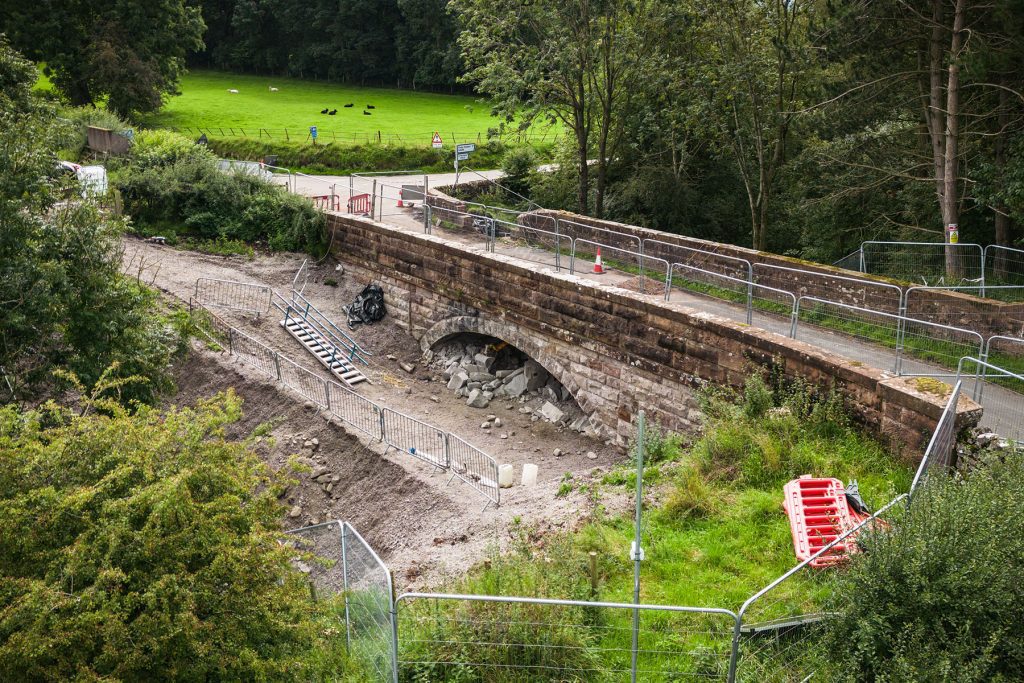Community groups have welcomed work to restore a historic railway bridge in Cumbria’s Eden valley following its controversial infilling in 2021.
National Highways buried the attractive masonry arch at Great Musgrave in 1,600 tonnes of stone and concrete despite inspection reports describing it as being in Fair condition, with only a few minor defects. The structure was repointed in 2012, restoring its capacity to 44 tonnes, but the state-owned roads company claimed it was weak because a small number of mortar joints had reopened.

The bridge was a valued landscape asset, intended for eventual reuse as part of a link between two heritage railways.
A request from the now-defunct Eden District Council not to start infilling was rejected by National Highways and the scheme was instead pushed forward under emergency permitted development rights that only last for 12 months. A retrospective planning application for the infill’s retention was turned down in June 2022 and an enforcement notice subsequently issued for its removal.
The work has to be completed by 11 October and the vital road over the bridge has been closed until then, prompting complaints locally about the significant disruption to nearby communities and farms. For larger vehicles, the diversionary route between the bridge’s two ends – which are just 30 yards apart – involves a journey of almost 14 miles.
“Lots of people believe they’re getting their own back on us for rejecting the infill scheme”, says Tim Wells, chair of Musgrave Parish Council. “They are meant to be responsible public servants, but we just feel bullied by them. They make it sound as though it’s our fault. The council asked them not to start their infill scheme, but they refused and forced it through under emergency rights. That’s why we are where we are.”
The area around the bridge is currently secured by fencing and the site is monitored by CCTV cameras. Over the past few weeks, stone has been removed from embankments at both sides to reveal blockwork walls beneath the arch, built to retain the concrete when it was pumped into the void between them. Contractors have since cored holes into the solidified concrete before breaking it out to reveal the bridge’s stonework. Once the material is removed, National Highways intends to carry out repairs.
“It’s good to see this sorry saga slowly coming to an end”, says Mike Thompson, Project Manager for the Stainmore Railway Company, one of the heritage operations affected by the infilling. “But we have some concerns about what happens next. Specialists in masonry arch structures assure us that Great Musgrave bridge had a capacity of more than 44 tonnes before infilling, but we expect National Highways will strengthen it anyway, just to make a point.
“On the old railway from Penrith to Keswick – which has been proposed for reopening for many years – they carried out two other bridge infill schemes in 2021, using steel arches to form a passageway through the concrete for the track. But the arches aren’t big enough for trains, so if the line is ever relaid, the structures will have to be rebuilt. That would obviously be a problem if they did the same thing at Great Musgrave. The opening beneath the span must be returned to its original size.”
Graeme Bickerdike, a member of The HRE Group of engineers, heritage campaigners and greenway developers, said: “The re-emergence of Great Musgrave bridge is obviously very welcome, restoring a valued landscape asset that’s embedded in the community’s history and might yet play a role in its future, spanning a proposed link between two heritage railways.
“But this saga leaves a bad taste and many unanswered questions. National Highways has implemented a new management process since the structure’s vandalism prompted the government to intervene and halt the company’s infill programme. But what about the culture that was driving it: has that been transformed?”
National Highways’ planning application to retain infill at another legacy railway bridge near King’s Lynn is expected to be determined by the local council’s planning committee in the next six weeks. So far, more than 350 people have lodged objections to the scheme, which resulted in the burial of an early and rare-surviving concrete structure, built using a modular system devised by renowned engineer William Marriott.






